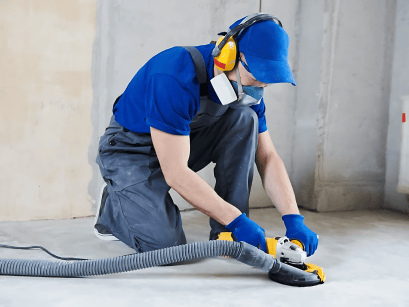Concrete grinding is a crucial step in many construction and renovation projects. It helps smoothen surfaces, remove imperfections, and prepare floors for further treatments. However, like any construction activity, concrete grinding comes with its own set of risks and hazards. In this blog post, we will discuss the best practices and equipment for ensuring safety during concrete grinding in Melbourne.
Understanding the Risks
Before delving into the safety measures, it is important to recognize the potential risks associated with concrete grinding in Melbourne. Dust is the primary concern in this process, as it contains crystalline silica particles that can be harmful if inhaled over prolonged periods. Silica dust exposure can lead to lung diseases such as silicosis, lung cancer, and chronic obstructive pulmonary disease (COPD). Additionally, noise pollution, vibrations, and the handling of heavy equipment pose additional safety challenges.

Personal Protective Equipment (PPE)
Wearing appropriate personal protective equipment is paramount to protect workers from the hazards of concrete grinding in Melbourne. In Melbourne projects, workers should always use PPE such as:
- Respiratory Protection: Respirators or masks fitted with P2 filters should be worn to minimize the inhalation of silica dust. This is particularly crucial when working indoors or in confined spaces where ventilation may be limited.
- Eye Protection: Safety glasses or goggles are essential to shield the eyes from flying debris and dust particles.
- Hearing Protection: Earplugs or earmuffs should be worn to protect against the high noise levels generated during the grinding process.
- Hand and Foot Protection: Sturdy gloves and safety boots with reinforced toe caps provide protection against cuts, abrasions, and falling objects.
Dust Control
Controlling dust is a crucial aspect of concrete grinding in Melbourne safety. Here are some effective measures to minimize dust exposure:
- Wet Grinding: Utilize wet grinding techniques to suppress dust generation. Wet grinding involves spraying water onto the concrete surface during the grinding process. This helps to keep the dust particles from becoming airborne.
- Local Exhaust Ventilation (LEV): Employ LEV systems equipped with HEPA filters to capture and remove dust at the source. These systems effectively reduce the amount of dust in the air, enhancing worker safety.
- Vacuum Systems: Use industrial-grade vacuum systems with HEPA filters to clean up dust and debris during and after grinding. Regularly empty and maintain the vacuum to ensure optimal performance.
Equipment Safety
- Use Certified Equipment: Choose grinding machines and tools that comply with Australian safety standards and regulations. Certified equipment is designed to minimize hazards and maximize worker safety.
- Guarding: Install appropriate guards on grinding machines to prevent accidental contact with moving parts. Guards protect workers from injuries and help maintain a safe work environment.
- Regular Inspections: Conduct routine inspections of grinding equipment to identify any damaged or worn-out components. Repair or replace faulty parts immediately to prevent accidents or malfunctions.
Training and Education
Investing in proper training and education for workers is vital to ensure their safety during concrete grinding in Melbourne. Provide comprehensive training programs that cover:
- Safe Handling and Operation of Equipment: Train workers on the correct usage and operation of grinding machines and tools. Emphasize the importance of following safety guidelines and using PPE.
- Hazard Awareness: Educate workers about the risks associated with silica dust exposure, noise, and vibrations. Promote a safety-conscious work culture that encourages proactive hazard identification and reporting.
- Emergency Procedures: Train workers on emergency procedures in case of accidents, injuries, or equipment malfunctions. Ensure they are familiar with first aid techniques and know how to access medical assistance promptly.
- Emergency Procedures: Train workers on emergency procedures in case of accidents, injuries, or equipment malfunctions. Ensure they are familiar with first aid techniques and know how to access medical assistance promptly.
Conclusion
Concrete grinding in Melbourne plays a critical role in achieving smooth and flawless surfaces in construction projects. However, safety should always remain a top priority. By adhering to the best practices outlined in this blog post, including wearing proper PPE, controlling dust, ensuring equipment safety, and providing comprehensive training, Melbourne projects can be executed with a focus on worker safety. Remember, a safe working environment leads to better productivity, higher morale, and ultimately, successful project outcomes. Stay safe, and happy grinding!







